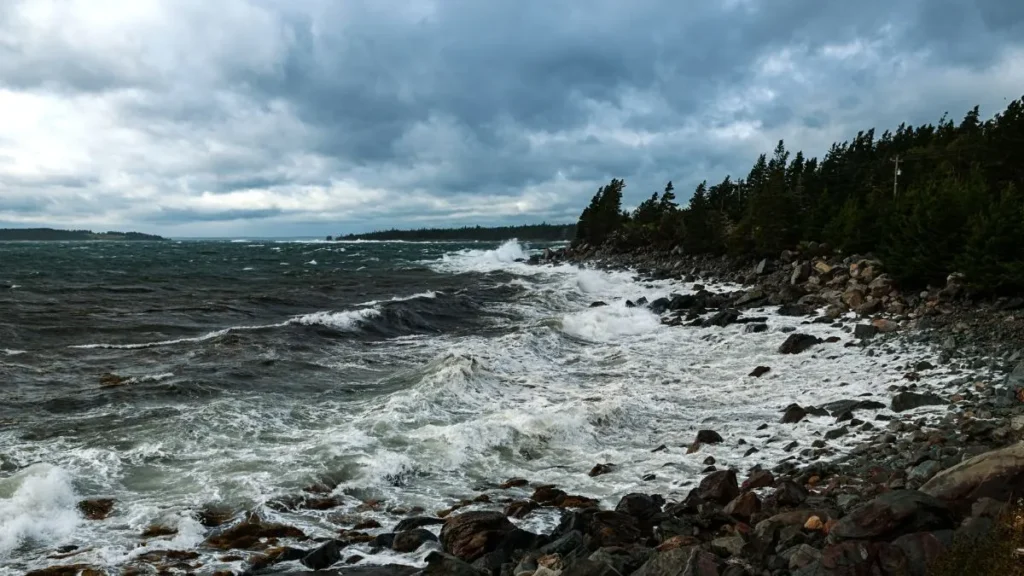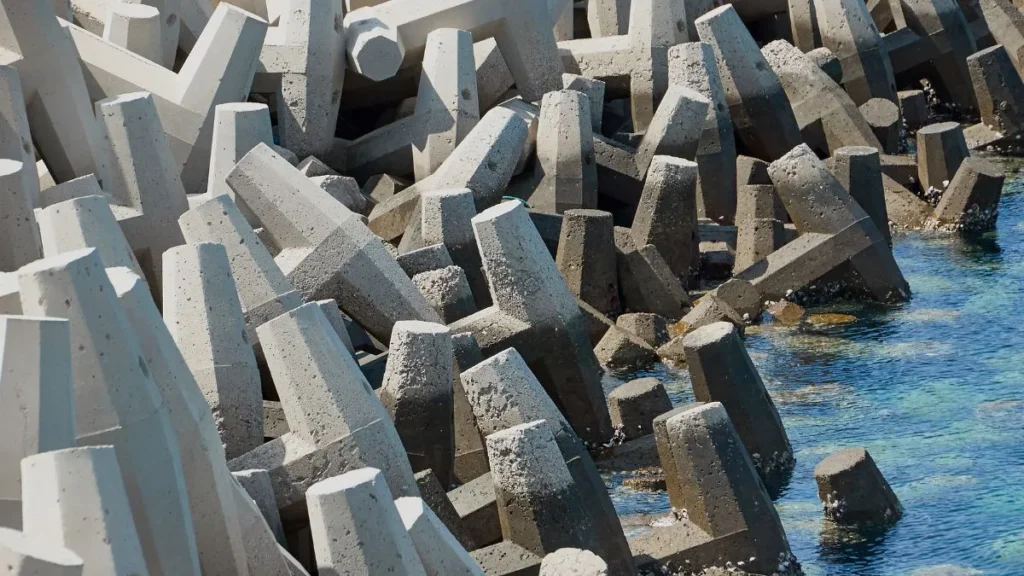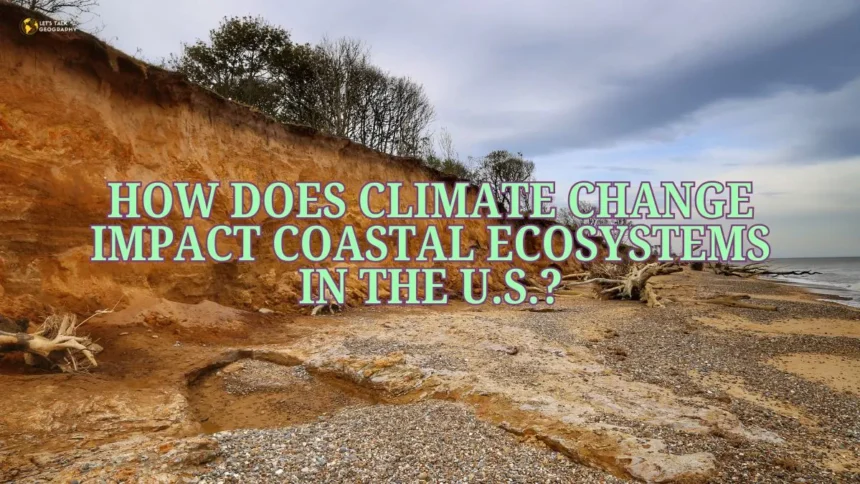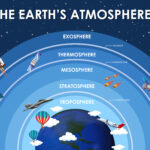Introduction
How does climate change impact coastal ecosystems in the U.S.? As our planet warms, sea levels rise, and extreme weather events become more frequent, the delicate balance of these ecosystems is under serious threat. Coastal ecosystems—which include marshes, wetlands, coral reefs, and estuaries—are vital for biodiversity and the protection of coastal communities. Yet, many of these ecosystems are now on the front lines of climate change.
In this article, we’ll explore the threats to U.S. coastal ecosystems, the species most affected by climate change, and the strategies our government is adopting to protect these vital areas.
How Does Climate Change Impact Coastal Ecosystems In The U.S.?
The question of how climate change impacts coastal ecosystems in the U.S. is multifaceted. U.S. coastal ecosystems face multiple challenges, from rising sea levels and acidification to increased storm intensity and erosion.
1. Rising Sea Levels and Habitat Loss
How does climate change impact coastal ecosystems in the U.S.? One of the most evident effects is rising sea levels. According to the National Oceanic and Atmospheric Administration (NOAA), sea levels along U.S. coastlines have risen by about 8 inches over the past century. They are expected to rise by 1-4 feet by 2100. This rise threatens U.S. coastal ecosystems, including salt marshes, mangroves, and wetlands.
These ecosystems are essential nurseries for marine life and act as natural barriers against flooding and storm surges. As sea levels rise, these habitats are submerged, leading to the displacement of species and loss of biodiversity.
Species Affected:
- Salt Marsh Sparrow: This bird, found along the Atlantic coast, relies heavily on salt marshes for breeding. As these habitats diminish, their nesting grounds become increasingly scarce.
- Diamondback Terrapins: Inhabiting coastal wetlands, these turtles face habitat shrinkage, putting their populations at risk.
2. Ocean Acidification and Coral Reef Degradation
Another way climate change impacts coastal ecosystems in the U.S. is through ocean acidification. As the ocean absorbs increased carbon dioxide, it becomes more acidic, endangering coral reefs, some of the most biodiverse ecosystems on Earth.
Coral reefs in regions like the Florida Keys and Hawaii are already experiencing these effects. The increased acidity hinders corals’ ability to build and maintain their skeletons, weakening the reefs and making them more vulnerable to bleaching, storm damage, and disease.
Species Affected:
- Staghorn Coral: This fast-growing coral in the Florida Keys has seen an 80% decline due to the combined effects of acidification and bleaching.
- Hawaiian Monk Seal: This endangered species relies on healthy coral reefs for food. As reefs degrade, these seals must travel further to find prey, risking survival.
3. Changes in Coastal Wetlands and Mangroves
Wetlands and mangroves are crucial components of coastal ecosystems, providing carbon sequestration and shielding inland areas from storm surges. However, climate change impacts coastal ecosystems in the U.S. by altering temperatures and precipitation patterns, which affects these habitats.
As wetlands shrink due to these changes, increased flooding, erosion, and biodiversity loss follow. Rising sea levels are especially dangerous for mangroves, vital for protecting coastal areas from erosion and providing habitats for numerous species.
Read also: Shocking: Mangroves are Ignored, and Our Coasts Are Paying the Price
Species Affected:
- American Alligator: This reptile, found in the coastal wetlands of the southeastern U.S., depends on these environments for nesting and feeding. As wetlands shrink, their habitat becomes increasingly fragmented.
- Brown Pelican: Found along the Gulf of Mexico and Atlantic coasts, brown pelicans rely on healthy mangroves for nesting. The loss of these trees threatens their populations and breeding success.
4. Increased Storm Frequency and Intensity
Climate change impacts U.S. coastal ecosystems by intensifying storm frequency and power. More frequent and severe storms cause devastating storm surges that erode coastlines and disrupt habitats. This erosion endangers species that depend on these coastal ecosystems, such as the brown pelican, which struggles to thrive in areas where habitats are frequently destroyed.

5. Coastal Erosion
Finally, how does climate change impact coastal ecosystems in the U.S.? Coastal erosion is a significant issue. Rising sea levels and warmer temperatures accelerate erosion, threatening nesting and feeding grounds for species like the piping plover. This erosion impacts wildlife and puts human infrastructure at risk, necessitating costly mitigation measures.
Read also: How Coastal Erosion Due to Climate Change is Destroying U.S. Cities – 5 Urgent Solutions
Key Takeaways:
- Sea-Level Rise: Submerges low-lying habitats, affecting species like the salt marsh sparrow.
- Ocean Acidification: Degrades coral reefs, impacting the Hawaiian monk seal.
- Wetland Changes: Alters ecosystems essential for the American alligator.
- Storms & Erosion: Increases frequency and intensity of storms, damaging coastal habitats and species.
Government Strategies to Combat Climate Change and Protect Coastal Ecosystems
The U.S. government has initiated several strategies to combat these challenges, protect U.S. coastal ecosystems, and ensure the longevity of natural habitats that sustain coastal communities. Below, we discuss some critical efforts.
Restoring Wetlands and Coastal Areas
One effective strategy to combat climate change’s impact on coastal ecosystems in the U.S. is restoring degraded wetlands and coastal areas. The government invests heavily in initiatives like the National Wetlands Restoration Program, spearheaded by the U.S. Environmental Protection Agency (EPA).
This program focuses on restoring wetlands nationwide, enhancing their natural ability to act as buffers against storms and sequester carbon, thereby mitigating the effects of climate change.
Wetlands and mangroves are crucial to maintaining healthy U.S. coastal ecosystems. They store carbon and serve as a natural defense mechanism against extreme weather events. By protecting and restoring these areas, the government supports biodiversity and provides essential services to coastal communities.
Coral Reef Protection and Monitoring
How does climate change impact coastal ecosystems like coral reefs? Coral reefs are particularly vulnerable to rising sea temperatures, which can lead to coral bleaching and damage. The U.S. government has implemented coral reef monitoring programs through agencies like the National Oceanic and Atmospheric Administration (NOAA) to safeguard these vital habitats in states like Florida and Hawaii.
For instance, the Coral Restoration Foundation in the Florida Keys actively transplants coral fragments to damaged reefs to enhance their recovery. Efforts such as these are crucial in preserving coastal ecosystems and minimizing the effects of climate change.
Expanding the National Coral Reef Monitoring Program is also on the agenda to evaluate the long-term impact of climate change on coral reefs in the U.S., allowing for better conservation and management strategies.
Read also: Shocking 2024: Coral Reefs on Death Row: The Coastal Devastation to Come
Managing Sea Level Rise with Nature-Based Solutions
Another major concern for U.S. coastal ecosystems is rising sea levels, threatening coastal areas and human settlements. To counter these effects, the U.S. government is adopting nature-based solutions, such as living shorelines. Living shorelines incorporate natural elements like plants, sand, and oyster reefs to stabilize and protect coastlines, demonstrating how integrating nature-based methods can effectively manage coastal ecosystems’ challenges.
The Army Corps of Engineers, a key player in this approach, is developing coastal resilience plans that combine these natural defenses with traditional infrastructure to create comprehensive protection for vulnerable coastal regions. These strategies illustrate the commitment to sustaining U.S. coastal ecosystems and minimizing climate change’s impact on these crucial habitats.
Key Takeaways
- How does climate change impact coastal ecosystems in the U.S.? It threatens wetlands, coral reefs, and human communities.
- Wetland restoration programs enhance coastal resilience, supporting biodiversity and carbon storage.
- Coral reef monitoring and restoration efforts aim to protect these ecosystems from rising sea temperatures and coral bleaching.
- Nature-based solutions like living shorelines stabilize U.S. coastal ecosystems and mitigate the effects of sea level rise.
| Ecosystem | Primary Threat | Key Species Affected | Government Strategies |
| Coral Reefs | Ocean acidification, bleaching | Staghorn coral, Hawaiian monk seal | Coral restoration, reef monitoring |
| Wetlands | Rising sea levels, erosion | Salt marsh sparrow, American alligator | Wetland restoration, carbon sequestration |
| Mangroves | Habitat loss, rising seas | Brown pelican, diamondback terrapin | Coastal buffer zones, living shorelines |
| Estuaries | Pollution, temperature rise | Striped bass, blue crabs | Water quality improvements, habitat restoration |
Future Plans to Cope with Climate Change Effects on Coastal Ecosystems
As we explore the effects of climate change and the government’s future plans to address these issues, we must understand the strategies implemented to safeguard these vital habitats.
Expanding Protected Areas in U.S. Coastal Ecosystems
Expanding protected areas is one critical approach to addressing how climate change impacts coastal ecosystems in the U.S. The U.S. government is committed to increasing its marine sanctuaries and coastal reserve network, which aims to better protect coastal ecosystems and preserve biodiversity.
The government plans to boost funding for the National Marine Sanctuaries Program to achieve this. This program is instrumental in safeguarding marine ecosystems and supporting scientific research on how climate change impacts coastal ecosystems in the U.S. Through this initiative; we hope to mitigate damage and ensure these protected regions remain resilient.

Enhancing Carbon Sequestration Programs
Another crucial strategy the government prioritizes is enhancing carbon sequestration initiatives within U.S. coastal ecosystems. Understanding how climate change impacts coastal ecosystems in the U.S., it’s evident that the amount of carbon dioxide in the atmosphere significantly contributes to warming trends.
The government’s solution is to restore and preserve coastal wetlands and mangroves, natural environments that capture carbon. These habitats are integral to U.S. coastal ecosystems, serving as carbon sinks and providing essential habitats for wildlife.
By expanding carbon sequestration programs, the aim is to reduce carbon emissions and curb the rate of global warming.
Investing in Ocean Acidification Research and Mitigation
Ocean acidification directly results from increased carbon dioxide levels and harms coral reefs within U.S. coastal ecosystems. The government has recognized the need for more focused research and mitigation strategies.
Programs are being developed to monitor ocean chemistry and study the effects of acidification on marine life. This research is vital to understanding how climate change impacts coastal ecosystems in the U.S. and will inform future policies and conservation strategies.
Read also: Ocean Acidification: Unveiling the Hidden Crisis Threatening Marine Life
Coastal Resilience Projects to Combat Sea-Level Rise
Another vital aspect of government efforts is combating sea-level rise, a pressing issue affecting U.S. coastal ecosystems. Coastal resilience projects are designed to strengthen natural barriers such as dunes, wetlands, and mangroves. These efforts help protect coastal ecosystems from erosion and flooding, which are becoming increasingly common due to climate change.
By investing in nature-based solutions, the government hopes to maintain the integrity of U.S. coastal ecosystems and reduce the risk posed by extreme weather events.
Key Takeaway
There is hope through strategic government initiatives such as expanding protected areas, enhancing carbon sequestration programs, and investing in resilience projects. These actions are designed to mitigate the effects of climate change and safeguard coastal ecosystems for future generations, ensuring that these habitats remain a vital part of the U.S. environmental landscape.
Conclusion
Climate change significantly challenges U.S. coastal ecosystems, which provide critical services to wildlife and human communities. While the threats of rising sea levels, ocean acidification, and habitat loss are immense, there is hope in government strategies and restoration efforts to preserve these vital ecosystems.
As we move forward, it is clear that protecting coastal ecosystems is not just an environmental priority but a necessary step in safeguarding the health, safety, and prosperity of coastal regions across the United States. By taking proactive measures now, we can ensure that future generations inherit a resilient and thriving coastal environment.
FAQs
1. How does climate change affect coastal ecosystems?
Climate change leads to rising sea levels, increased ocean temperatures, and ocean acidification, all damaging coastal habitats like coral reefs, wetlands, and mangroves.
2. What species are most affected by climate change in coastal areas?
Species like the salt marsh sparrow, staghorn coral, and diamondback terrapin are especially vulnerable due to habitat loss and environmental changes caused by climate change.
3. How is the U.S. government addressing climate change impacts on coastal ecosystems?
The government invests in wetland restoration, coral reef protection, and nature-based solutions like living shorelines to mitigate climate change’s effects on coastal ecosystems.
4. What plans does the U.S. have to protect coastal ecosystems?
Plans include expanding protected areas, enhancing carbon sequestration programs, and increasing funding for monitoring and restoration projects.
5. Can coastal ecosystems recover from climate change impacts?
Some ecosystems can recover with targeted restoration efforts and protection measures, though long-term success depends on reducing global carbon emissions and ongoing conservation efforts.
6. What role do wetlands play in combating climate change?
Wetlands act as carbon sinks and natural barriers against storms, helping protect U.S. coastal ecosystems.





